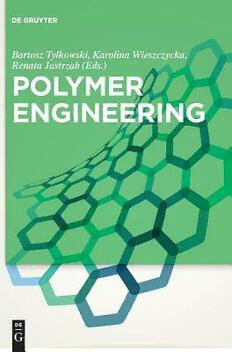
Polymer Engineering PDF
Preview Polymer Engineering
Tylkowski,Wieszczycka,Jastrzab(Eds.) PolymerEngineering Also of interest PolymerSurfaceCharacterization Sabbatini(Ed.),2014 ISBN978-3-11-027508-7,e-ISBN978-3-11-028811-7 FunctionalMaterials. ForEnergy,SustainableDevelopmentandBiomedicalSciences Leclerc,Gauvin(Eds.),2014 ISBN978-3-11-030781-8,e-ISBN978-3-11-030782-5 Microencapsulation. InnovativeApplications Giamberini,FernandezPrieto,Tylkowski(Eds.),2015 ISBN978-3-11-033187-5,e-ISBN978-3-11-033199-8 Electrospinning. APracticalGuidetoNanofibers Agarwal,Burgard,Greiner,Wendorff,2016 ISBN978-3-11-033180-6,e-ISBN978-3-11-033351-0 ChemicalSynergies. FromtheLabtoInSilicoModelling Bandeira,Tylkowski(Eds.),2018 ISBN978-3-11-048135-8,e-ISBN978-3-11-048206-5 PhysicalSciencesReviews. e-ISSN2365-659X Polymer Engineering Edited by BartoszTylkowski,KarolinaWieszczycka,RenataJastrzab Editors Dr.BartoszTylkowski ChemistryTechnologyCentreofCatalonia(CTQC), C/Marcel·líDomingo, 43007Tarragona,S Spain [email protected] Dr.hab.KarolinaWieszczycka PoznanUniversityofTechnology InstituteofChemicalTechnology&Engineering Berdychowo4 60-965Poznan Poland [email protected] Prof.UAMRenataJastrzab AdamMickiewiczUniversity FacultyofChemistry Umultowska89b 61-614Poznan Poland [email protected] ISBN978-3-11-046828-1 e-ISBN(PDF)978-3-11-046974-5 e-ISBN(EPUB)978-3-11-046834-2 Set-ISBN978-3-11-046975-2 ThearticlesinthisbookhavebeenpreviouslypublishedinthejournalPhysicalSciencesReviews (ISSN2365-659X). LibraryofCongressCataloging-in-PublicationData ACIPcatalogrecordforthisbookhasbeenappliedforattheLibraryofCongress. BibliographicinformationpublishedbytheDeutscheNationalbibliothek TheDeutscheNationalbibliothekliststhispublicationintheDeutscheNationalbibliografie;detailed bibliographicdataareavailableontheInternetathttp://dnb.dnb.de. ©2017WalterdeGruyterGmbH,Berlin/Boston Typesetting:IntegraSoftwareServicesPvt.Ltd. Printingandbinding:CPIbooksGmbH,Leck Coverimage:RGAP/iStock/Thinkstock ♾Printedonacid-freepaper PrintedinGermany www.degruyter.com Preface Polymerisatermusedsince1866byBerthelotwho,inapublicationreleasedinthe BulletinoftheChemicalSocietyofFrance,notedthat“styrolene(styrene),heatedat 200°C during a few hours, transforms itself into a resinous polymer”. It was the first recognizedsyntheticpolymer.However,HermannStaudingerwasthefirstonewhoin 1920proposedtheconceptofpolymersinthesensethatweusetoday.Theuniversality of polymers is now well established. They are present in all fields of industrial production as an additive or structural materials and are impossible to avoid. The improvementof theirpropertiesgraduallyremovedtheir badreputationand,nowa- daysonecansay“Therearenobadpolymers,onlybadapplicationsofthem”. The book aimsto review the artof polymers andto provide thereaders with a comprehensive and in-depth understanding of recent developments in polymers science,technologiesandengineering.Chapter1explainsanimprovementofmod- ified epoxy thermosets by using different hyperbranched poly(ethyleneimine) deri- vatives. Chapter 2 provides an overview on developments in the use of rare earth metals complexes as efficient catalysts for ring-opening polymerization of cyclic estersusedinbiomedicalapplications.Chapters3and4emphasizeknowledgeand recent advances in bioartificial polymers and based nanovectores. The topics detailed in Chapters 5–7 provide current developments in capsules technologies, polymeradditivesandpolymersapplicationinconsumergoodsproducts.Chapters 8-10 describe polymers application in membrane technologies, while Chapter 11 provides modeling and simulation understanding membrane process. Nanomaterials often show unique and considerably changed physical, chemical and biological properties compared to their macro scaled counterparts. Utilization ofnanoparticlesoftenrequirestheconstructionofintegratedchemicalsystems.Most popular of these are polymer-supported nanoparticles, which are highlighted in Chapter12.SpectroscopicpropertiesofpolymercompositesaregiveninChapter13. Chapter 14 underlines catalytical and biological processes used to transform cellu- loseintohighvalue-addedproducts. Wewouldliketoexpressourgratitudetothecontributingauthorsinmakingthis project a success, and to Dr. Ria Fritz and Ms. Jana Habermann of DeGruyter Publisher, Germany for their assistance and encouragement in this venture. Moreover, we would like to gratefully acknowledge a financial support from EuropeanCommunity’sSeventhFrameworkProgramme(FP/2007–2013)underREA grant agreement no. 600388 (TECNIOspring programme), and from the Agency for Business Competitiveness of the Government of Catalonia, ACCIÓ, under which Dr. Tylkowski co-edits this book as a part of outreaching activity of his Individual IncomingTECNIOspringMarieCurieGrant. BartoszTylkowski KarolinaWieszczycka RenataJastrzab https://doi.org/10.1515/9783110468281-202 Contents Preface V Listofcontributingauthors XV CristinaAcebo,XavierRamisandAngelsSerra 1 Improvedepoxythermosetsbytheuseofpoly(ethyleneimine) derivatives 1 1.1 Generalintroduction 1 1.2 Generalconceptsofepoxythermosets 1 1.3 Curingagents 3 1.4 Characteristicsofepoxythermosets 9 1.4.1 Toughness 10 1.4.2 Shrinkage 11 1.4.3 Reworkability 12 1.4.4 Scratchresistance 13 1.5 Dendriticpolymers 14 1.5.1 Hyperbranchedpolymers 16 1.5.2 Starpolymers 17 1.6 ModifiedepoxythermosetsbyusingHBPsandotherhighly branchedtopologies 18 1.7 HBPsandmultiarmSPsfromPEI 20 1.8 ModificationofhyperbranchedPEIwithlongalkylchainsandits useasmodifierinepoxythermosets 23 1.9 SynthesisofmultiarmSPsbyROPandtheiruseasmodifiersin epoxythermosets 25 1.10 EthoxysilylationofhyperbranchedPEIandtheuseinthe preparationofhybridthermosets 29 1.11 UseofmodifiedhyperbranchedPEIasamacromonomerinthe preparationofthermosetsbyatwo-stageclick-chemistry process 33 References 38 IulianaCota 2 Developmentsintheuseofrareearthmetalcomplexesasefficient catalystsforring-openingpolymerizationofcyclicestersusedin biomedicalapplications 51 2.1 Biodegradablepolymers 51 2.2 Polymerizationmechanismsforpolyestersynthesis 52 2.3 CatalystsforROPofPLAs 55 2.4 Rareearth-basedcatalystsforsynthesisofPLAs 56 VIII Contents 2.5 Conclusions 77 References 79 KamilaSzałataandTaniaGumi 3 BioArtificialpolymers 85 3.1 Introduction 85 3.2 Biomoleculeimmobilizationtechniques 87 3.2.1 Adsorption 87 3.2.2 Covalentbinding 88 3.2.3 Entrapment 88 3.2.4 Encapsulation 89 3.3 Polymer/biomoleculeconjugates 89 3.3.1 Enzymes 90 3.3.2 Polysaccharides 94 3.3.3 Channels 98 3.3.4 Nucleicacids 101 3.3.5 Cells 104 3.4 Summary 106 References 107 RaffaeleConte,IleniaDeLuca,AnnaValentino,AnnaDiSalle,AnnaCalarco, FrancescoRiccitielloandGianfrancoPeluso 4 Recentadvancesin“bioartificialpolymericmaterials”based nanovectors 113 4.1 Introduction 113 4.1.1 Bioartificialpolymericmaterials 113 4.1.2 Nanotechnologyandmedicine 115 4.2 Bioartificialpolymericnanovectors 116 4.2.1 NanospheresandNanocapsules 117 4.2.2 Nanohydrogelsandnanoaggregates 122 4.2.3 Micelles(MCs)andsolidlipidnanoparticles(SLNs) 125 4.2.4 Nanofibers 129 4.3 Conclusion 133 References 133 ValentinaMarturano,PierfrancescoCerrutiandVeronicaAmbrogi 5 Polymeradditives 139 5.1 Introduction 139 5.1.1 Roleofpolymeradditives 139 5.1.2 Additivesincorporationinpolymerformulation 140 5.2 Plasticizers 141 Contents IX 5.2.1 Mechanismofplasticisation 142 5.2.2 Classificationofplasticizers 143 5.2.3 Bio-basedplasticizers 145 5.3 Flameretardants 145 5.3.1 HalogenatedFRs 146 5.3.2 Phosphorus-basedFRs 148 5.3.3 InorganicFRs 148 5.3.4 Bio-basedFRs 148 5.4 Impactmodifiers 150 5.4.1 Butadienebasedgraftcopolymers 151 5.4.2 Acrylicmodifiers 152 5.4.3 Elastomers 153 5.5 AntioxidantsandUVstabilizers 153 5.5.1 Antioxidants 153 5.5.2 UVstabilizers 158 5.5.3 Naturalantioxidants 160 5.6 Antimicrobials 162 5.6.1 Organicantimicrobialagents 162 5.6.2 Inorganicantimicrobialagents 163 5.6.3 Naturalantimicrobialadditivesforpolymers 165 References 166 AnnaTrojanowska,AdriannaNogalska,RicardGarciaValls,MartaGiamberini andBartoszTylkowski 6 Technologicalsolutionsforencapsulation 171 6.1 Introduction 171 6.2 Chemicalmethods 173 6.2.1 Interfacialpolymerization 173 6.2.2 Insitupolymerization 176 6.3 Physicochemicalmethods 179 6.3.1 Coacervation 179 6.3.2 Layerbylayer 181 6.3.3 Sol–gelencapsulation 184 6.3.4 Suspensioncross-linking 185 6.4 Physicomechanicalmethods 186 6.4.1 Spray-drying 186 6.4.2 Co-extrusion 190 6.4.3 Fluidized-bedspraycoating 194 6.4.4 Phase-inversionprecipitation 195 6.5 Generalconclusions 196 References 197 X Contents MonissaPaderes, DeepakAhirwalandSusanaFernándezPrieto 7 Naturalandsyntheticpolymersinfabricandhomecare applications 203 7.1 Introduction 203 7.2 Benefitsofpolymersinfabricandhomecareformulations 205 7.2.1 Soilrelease 206 7.2.2 Dispersant 207 7.2.3 Anti-redeposition 207 7.2.4 Dyetransferinhibitors 208 7.2.5 Rheologymodifier 209 7.3 Naturalandsyntheticpolymers 211 7.3.1 Syntheticpolymers 211 7.3.2 Naturalpolymers 219 7.3.3 Carrageenan 226 7.3.4 Alginates 228 7.4 Conclusions 229 References 230 KarolinaWieszczyckaandKatarzynaStaszak 8 Polymersinseparaionprocesses 235 8.1 Polymersasmembranes 235 8.1.1 Introduction 235 8.1.2 Reverseosmosis 237 8.1.3 Nanofiltration 238 8.1.4 Ultrafiltration 241 8.1.5 Dialysis 246 8.1.6 Membraneextraction 251 8.2 Polymerresins 255 8.2.1 Ion-exchangeresin 255 8.2.2 Solventimpregnatedresin 260 References 268 BartoszTylkowskiandIreneTsibranska 9 Polymerapplicationforseparation/filtrationofbiologicalactive compounds 277 9.1 Introduction 277 9.1.1 Membranesusedforseparationofbiologicallyactive compounds 278 9.1.2 Concentrationandpurificationofbioactivecompoundsfrom naturalextracts 279 9.1.3 Recoveryofextractionsolvents 287 References 288
